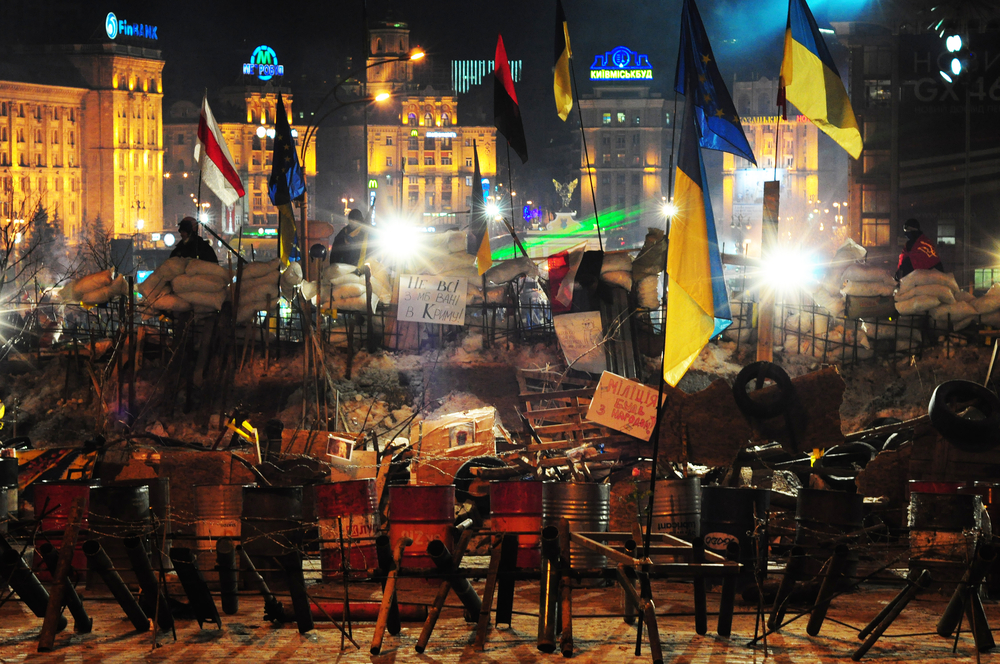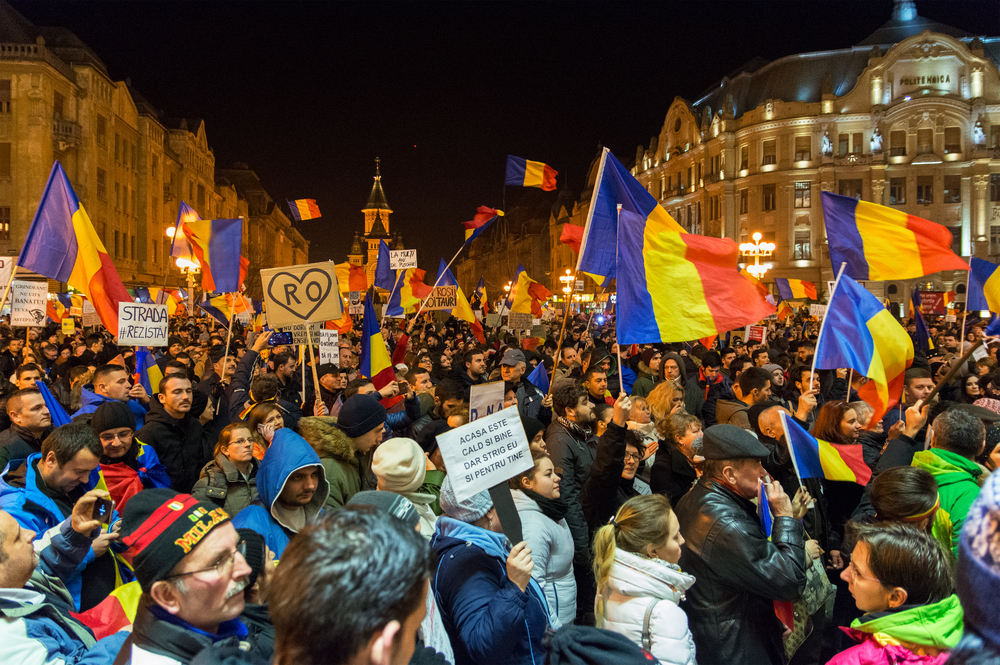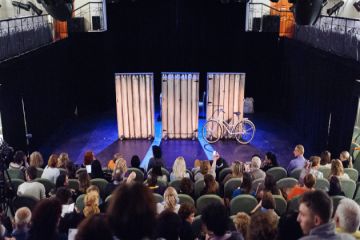The February Protests in Romania remind of the not so long ago Maidan protests in Ukraine, making us wonder how similar they are in reality, and where the similarities will stop. The situation in Ukraine is much more complex and much harder, so by no means this article is trying to diminish that. Still, the people of the two countries can learn from each other’s struggles.
Briefly, after the Parliamentary elections from December 2016, which were won by the socialists under a politician that is under investigation by the Anti-corruption Agency, an emergency law was passed that modified the law qualifying the abuse of power only the actions that result in a loss for the state of more than 45 000 euros (this was done late evening and was officially published in the middle of the night). In the course of the next days up to 600 000 people gathered in Bucharest and across the country in the big cities of Romania to protest against that law and against the newly formed government. 
What makes a Civil Society strong? The short answer is Time, Effort and Continuous Hope
For Romania it started a long time ago (about 15 years ago) and about 4 years ago the first fruits came out of it, when lots of people protesting, managed to save a village and 4 mountains that were given by the government (also a socialist one) to a Canadian gold mining company that promised to give 6% of the gold to the country, and would leave behind the biggest cyanide lake in Europe (more than 20 km in diameter). Later, people protested against the government and the administration that was responsible for giving the functioning permit to a club that shouldn’t have received it and which caught on fire killing more than 50 people.
How did the Romanian Civil society reach here? Immigration and freedom of movement paid off!
It really makes a big difference to understand how people outside your country live, what a country can offer to its people and what responsibilities should the people take over, and stop waiting for the state or other superior entity to fulfill them. Making people feel responsible for their country is one of the toughest things to do as it involves teaching them not to throw trash on the streets, not to destroy the public goods (like tram stations, train wagons, etc), but also how to live healthier and be happier. 
Once you start to feel responsible for your country, you start investing in it, either in the form of time or in the form of energy and you start protecting its nature, some of its freedoms, its constitution and its future.
Talking about the Ukrainian Civil society should be done only from the inside, by a Ukrainian, as any outside evaluation would be superficial. The questions a Ukrainian could ask himself or herself are: do I feel that I can influence the fate of my country? Do I have a say in what is happening with its future? The stronger the “Yes”, the more powerful the Civil society.
How do the corrupt politicians fight against the Civil Society?
The short answer is in the “Divide et impera” concept
Dividing people is one of the oldest and simplest ways to control people, because you just have to focus on their fears. Everyone has fears and if you manage to direct them towards other people or groups of people, you have Paralyzed them, you have created Dependence and have achieved Obedience.
It is amazing to see how Fears are much stronger than Reason and Logic, as the USA elections also have pointed this out. Theoretically it should not be possible for one person to promote all the Dividing messages because these are either in opposition, or are not shared by all the groups but the reality from the USA showed us that even that is possible.
From Power point of view it is much more efficient to blame groups of People for real problems (like immigration being responsible for unemployment, in the case of the USA) than to describe the truth (industrial automation replaces the lower layer of jobs), because a clearly stated problem will need a clear solution coming from the Leaders.
In Romania the politicians with their media try to divide people based on the fact that some are paid by the state (to which the government increased the wages) and some work in the private sector, or they try to divide them by regions by allocating the budget in a clearly disproportionate way favoring the south versus the north (a new division, not really historical) and by allocating a big budget to the cities and villages that voted for this party and not giving any money to the ones that voted for the opposition. Another way of dividing the people is based on the age: focusing on the pensionaries and removing the benefits given to the students. Fortunately, these are all very unnatural divisions and people can’t really accumulate the hatred for each other and use it publicly as it is hard to recognize on the street that one person is working for the private sector and another one for the public sector or that one is from Targoviste or Pitesti and another one is from Bucharest, Iasi or Timisoara. As for the age, lots of pensionaries came to protest as well, thinking about the future of their grand kids and disregarding the pension increase that they have received.
Still, there are people that are turned by the socialist party against the president (naively thinking that if the president would be removed, the people that are now against the corrupt government would suddenly not be against it anymore). The same people are also turned against the Anti-Corruption Agency (which supposedly is fabricating the prosecuting files of the politicians that are in power, disregarding the fact that politicians from all parties were prosecuted including the family of the former liberal president).
In Ukraine, the division was aimed at the deeper Identity level, by which language would define the national appurtenance. However if you think only about Belgium as a strong country, with the Vallons (French speakers) and Flemmings (Flemmish or Dutch speakers), while having a very Strong National identity you can accept that the situation of Ukraine can be similar. The topic is, however, so Emotional for any Ukrainian that any discussion or debate on it should be done only interactively and empathically. 
So, what’s next for Romania and Ukraine?
By understanding the “us versus them” mentality, the people that want to do something for the country will know what to do in order to engage in a constructive Dialog and thus avoid a Paralyzing full of Hatred Division.
By giving power to the journalists and supporting them, more transparency will be created and people will be able to decide for themselves if a law that was passed or a new development was good for them and for the state or was done for the interests of the people in power. This comes with its disadvantages but the disadvantages can be diminished with Education and a constructive Dialog.
By inviting more people to take a stand (to “talk about politics”) the Civil society will grow stronger and will guarantee that the politicians will have less chances of taking advantage of the state. In the same time, from the Civil Society the new politicians will rise that will be able to transform the country and change the old ways.
So how similar are the two countries’ struggles?
The latest law the parliament works on in Romania, is to be able to prosecute and put in jail the people that protest, as they disturb the functioning of the government (the similarity to what the Ukrainian parliament did in January 2014 is obvious).
A critical question for the Romanians would be whether the current political class is as determined to hold to its power as the Ukrainian political class was in the end of 2013, beginning of 2014.
But the last and most important question is: How can the people of these two countries help each other in terms of the Civil Society?
Photos: shutterstock.com







